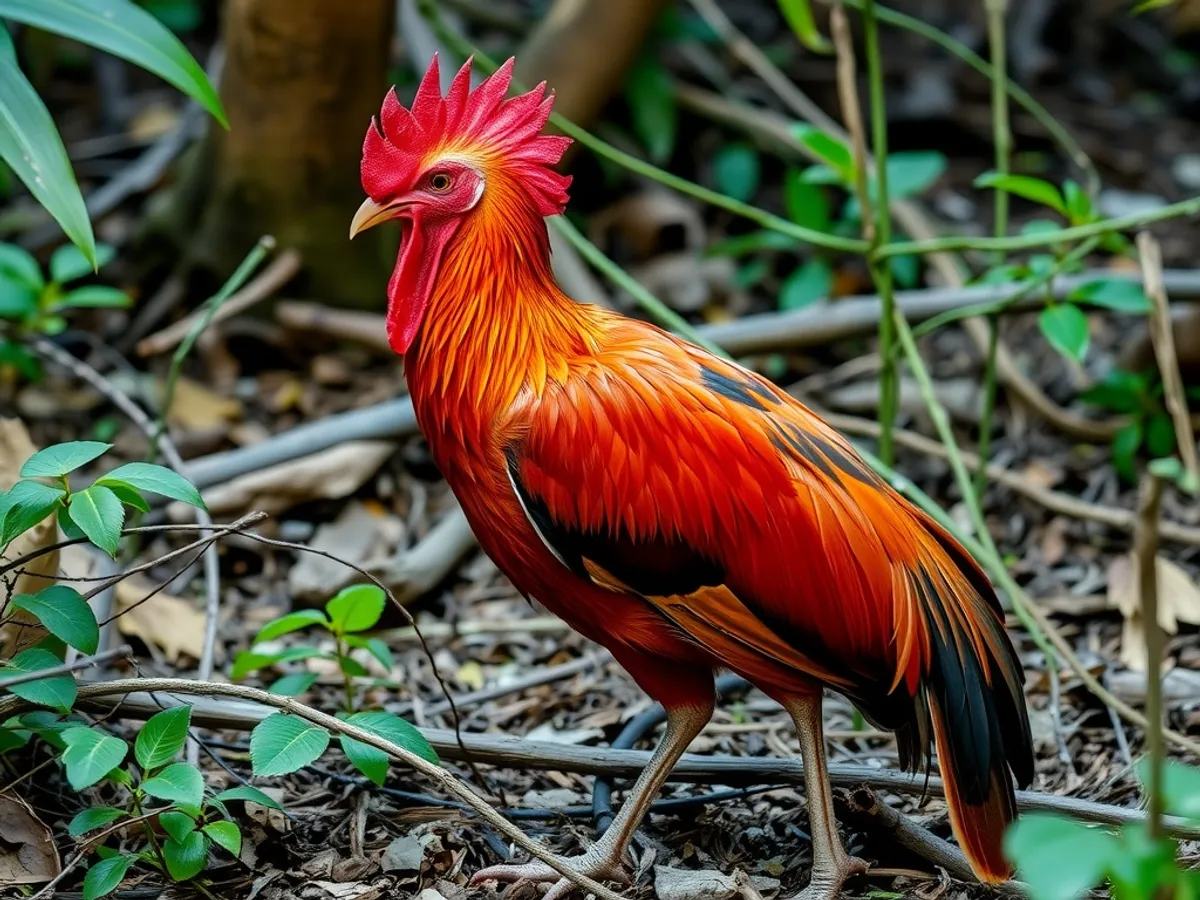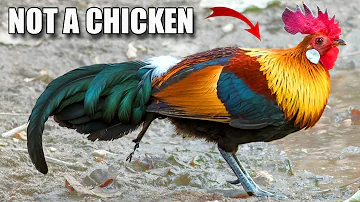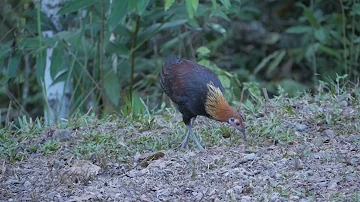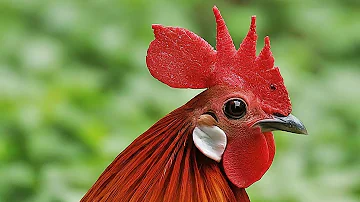
Red Junglefowl
Gallus gallus

Meet the Red Junglefowl
The Red Junglefowl is a colorful bird native to the forests and scrublands of South and Southeast Asia. Known for its striking plumage, the male sports iridescent red, gold, and green feathers with a prominent comb and wattles, while the females are more subdued in coloration. This species is the wild ancestor of the domestic chicken, and it exhibits complex social behaviors and vocalizations. Red Junglefowl are ground-dwelling birds that forage for food during the day and roost in trees at night. Their adaptability has allowed them to thrive in a variety of habitats, particularly near human settlements.
Classification
Bird
Habitat
Tropical and subtropical forests, scrublands, and agricultural edges
Diet
Omnivore
Lifespan
5-10 years
Conservation
Least Concern
Weight
0.5-1.2 kg
📖Fascinating Facts
Origin of Chickens
Red Junglefowl are the wild ancestors of all modern domestic chickens, with domestication traced back to Southeast Asia.
Roost in Trees
Despite spending much of their time on the ground, Red Junglefowl roost in trees at night to avoid predators.
Egg Laying
Females lay clutches of 4-7 eggs, and both parents can be involved in caring for the young, especially in the wild.
📋Detailed Description
The Red Junglefowl (Gallus gallus) is a medium-sized, ground-dwelling bird, with males typically measuring 65–75 cm in length and weighing 1–1.5 kg, while females are smaller, averaging 42–46 cm and 0.7–1 kg. Males display striking sexual dimorphism, with iridescent plumage in shades of red, orange, green, and black, elongated neck hackles, a prominent red comb, and wattles, which serve as visual signals in social and mating contexts. Females are cryptically colored in mottled brown and buff, providing camouflage during nesting. Both sexes have strong legs equipped with sharp spurs (more developed in males), aiding in defense and dominance contests. The species is highly vocal, with a repertoire of calls including the iconic 'cock-a-doodle-doo' crow, alarm calls, and complex social vocalizations. Red Junglefowl are diurnal, foraging on the ground for seeds, fruits, insects, and small vertebrates, while roosting in trees at night to avoid predators. Socially, they form small, stable groups called harems, typically consisting of one dominant male, several females, and their offspring. Hierarchies are established through ritualized displays and occasional combat. Their reproductive strategy involves elaborate courtship displays by males, including wing-flapping, tidbitting (food-offering), and vocalizations to attract females. Nests are shallow ground scrapes lined with vegetation, and females incubate clutches of 4–7 eggs for about 18–21 days, providing sole parental care post-hatching. The Red Junglefowl's adaptability to disturbed habitats and proximity to human settlements has facilitated its wide distribution and contributed to its role as the wild ancestor of the domestic chicken.
💡 Did you know?
Every domesticated chicken in the world is descended from the Red Junglefowl.
🔬Research & Sources
Wikipedia Summary
The red junglefowl, also known as the Indian red junglefowl, is a species of tropical, predominantly terrestrial bird in the fowl and pheasant family, Phasianidae, found across much of Southeast and parts of South Asia. The red junglefowl was the primary species to give rise to today's many breeds of domesticated chicken ; additionally, the related grey junglefowl, Sri Lankan junglefowl and the Javanese green junglefowl have also contributed genetic material to the gene pool of the modern chicken.
Last Modified: 6/10/2025
🎭Behavior & Social Structure
Red Junglefowl exhibit a complex social structure, with dominant males defending territories and harems from rivals. Daily activity peaks at dawn and dusk, with foraging interspersed with periods of dust-bathing and preening. Their omnivorous diet includes seeds, fallen fruits, insects, worms, and occasionally small reptiles or amphibians. Foraging is often cooperative, with adults alerting others to food sources or predators using specific calls. Males perform courtship displays and 'tidbitting'—a behavior where they pick up and drop food items while making a unique call to attract females. Aggressive interactions, particularly among males, involve threat postures, chasing, and physical combat using their spurs. Roosting occurs communally in trees, with individuals selecting high branches for safety. Vigilance is high, especially in open habitats, with sentinels alerting the group to danger.
👶Reproduction & Life Cycle
Breeding in Red Junglefowl is seasonal, typically coinciding with the onset of the rainy season (March–July in much of their range), which ensures food abundance for chicks. Males compete for access to females through displays and vocalizations. After mating, females select concealed sites on the ground to build nests, laying 4–7 cream to pale brown eggs. Incubation lasts 18–21 days, with the female solely responsible for brooding and chick care. Chicks are precocial, leaving the nest within 24 hours of hatching and following the mother closely. The female leads her brood to foraging sites, teaching them to recognize food and avoid predators. Fledging occurs at 4–5 weeks, but young may remain with the mother for several months. Multiple broods per season are possible in optimal conditions.
🛡️Adaptations & Survival
Red Junglefowl possess several adaptations for survival in dense forests and scrublands. Their cryptic plumage (especially in females and juveniles) provides camouflage from predators. Strong legs and sharp spurs enable rapid terrestrial movement and defense. Acute vision and hearing facilitate early predator detection. The ability to roost in trees at night reduces predation risk from terrestrial mammals. Behavioral flexibility allows them to exploit a variety of food sources and habitats, including agricultural edges and secondary growth. Social hierarchies and complex vocalizations aid in group cohesion and resource defense. Their reproductive strategy—precocial young and rapid development—maximizes survival in fluctuating environments.
🎨Cultural Significance
The Red Junglefowl holds immense cultural and historical significance as the primary ancestor of the domestic chicken (Gallus gallus domesticus), one of the world's most important livestock species. Domestication likely began over 8,000 years ago in Southeast Asia, profoundly impacting human societies through food production, religious symbolism, and art. In many cultures, the rooster symbolizes dawn, vigilance, and masculinity. Junglefowl feathers and cocks have been used in traditional rituals, cockfighting, and as status symbols. The bird features prominently in folklore, mythology, and iconography across Asia and beyond.
🔬Recent Research & Discoveries
Recent genomic studies have clarified the domestication history of chickens, revealing multiple domestication events and significant gene flow from other junglefowl species, notably the Grey Junglefowl (Gallus sonneratii). Ongoing research focuses on the genetic integrity of wild populations, the impact of hybridization, and the behavioral ecology of free-ranging groups near human settlements. Studies on vocal communication have highlighted the complexity of their social calls and the evolutionary basis of the rooster's crow. Conservation genetics projects are underway to identify and protect genetically pure populations, particularly in Southeast Asia.
🎥Wildlife Videos

Jungle Fowl Facts: the WILD CHICKEN?! 🐔 Animal Fact Files
Jungle fowl (sometimes spelled junglefowl) are sometimes called the wild chicken, but there are some differences between ...
Animal Fact Files

Ailao Mountains Series | Ep. 6: Red junglefowl
In Ailao Mountains, southwest China's Yunnan Province, the valley of the tropical monsoon forest remains silent in the afternoon.
CGTN Nature

Red Jungle Fowl I Dudhwa National Park
Red Jungle Fowl The Red Jungle Fowl (RJF) is one of the four jungle fowls found in the Indian Subcontinent belonging to the ...
The Wild Territory

Red Junglefowl (Gallus gallus)
Wild Chicken aka Red Junglefowl at Khao Yai National Park, Thailand.
Mark Andrews

Red Junglefowl
This 'original chicken' is smaller than its domestic descendants, and is widespread throughout South and Southeast Asia; can ...
Peek Into Nature

Junglefowls: The Living Ancestors of the Modern Chicken
The Red Junglefowl (Gallus gallus) is the primary ancestor of the domestic chicken (Gallus gallus domesticus). The Grey ...
Arcadia for Amateurs
🌍Habitat Information
The Red Junglefowl typically inhabits Tropical and subtropical forests, scrublands, and agricultural edges environments. Red Junglefowls have adapted to their environments with specialized features and behaviors.
Primary Habitat:
Tropical and subtropical forests, scrublands, and agricultural edges
More detailed habitat information will be available soon.
🛡️Conservation Status
The Red Junglefowl is currently classified as Least Concern. Conservation efforts are crucial for preserving this species for future generations.
Common Threats:
- 🏠Habitat loss and fragmentation
- 🌡️Climate change impacts
- 🎯Hunting and poaching
- 🏭Human-wildlife conflict
⚠️Threats & Conservation Challenges
Although classified as Least Concern by the IUCN, Red Junglefowl face several threats. Hybridization with domestic chickens is widespread, leading to genetic introgression and potential loss of wild-type traits. Habitat loss due to deforestation, agricultural expansion, and urbanization reduces available breeding and foraging grounds. Hunting for meat, feathers, and the pet trade persists in some regions. Disease transmission from domestic poultry poses additional risks. Despite these challenges, the species remains widespread and locally abundant, but pure wild populations are increasingly rare outside protected areas. Conservation efforts focus on habitat preservation and genetic monitoring to maintain wild lineages.
🔬Scientific Classification
Scientific Name
Gallus gallus
Classification Hierarchy
🔍 About Taxonomic Classification
Taxonomic classification is a hierarchical system used by scientists to classify and organize living organisms based on shared characteristics and evolutionary relationships.
The system moves from broad categories (Kingdom) to increasingly specific ones, with each animal's scientific name typically consisting of its Genus and species.
📝Community Notes
Share your observations and insights about the Red Junglefowl with our community of wildlife enthusiasts.
Join Our Community
Sign in to share your observations and connect with fellow wildlife enthusiasts.
Sign In to ContributeNo community notes yet
Be the first to share your observations about the Red Junglefowl!
Explore Red Junglefowl
Select a tab above to learn more about this amazing animal.
📸Photo Gallery
No photos available for this animal yet.
🌟Discover More Wildlife
Continue your journey of discovery with more fascinating animals from our database
